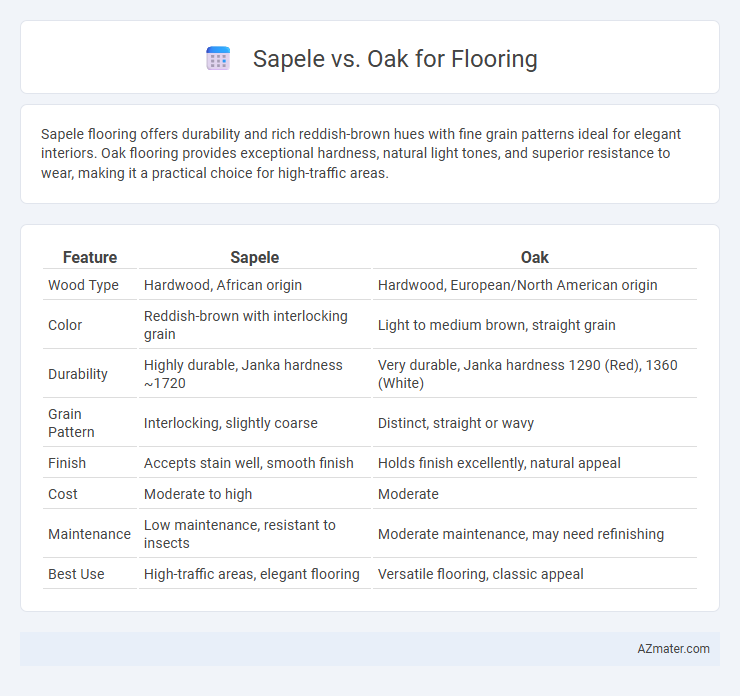Sapele flooring offers durability and rich reddish-brown hues with fine grain patterns ideal for elegant interiors. Oak flooring provides exceptional hardness, natural light tones, and superior resistance to wear, making it a practical choice for high-traffic areas.
Table of Comparison
| Feature | Sapele | Oak |
|---|---|---|
| Wood Type | Hardwood, African origin | Hardwood, European/North American origin |
| Color | Reddish-brown with interlocking grain | Light to medium brown, straight grain |
| Durability | Highly durable, Janka hardness ~1720 | Very durable, Janka hardness 1290 (Red), 1360 (White) |
| Grain Pattern | Interlocking, slightly coarse | Distinct, straight or wavy |
| Finish | Accepts stain well, smooth finish | Holds finish excellently, natural appeal |
| Cost | Moderate to high | Moderate |
| Maintenance | Low maintenance, resistant to insects | Moderate maintenance, may need refinishing |
| Best Use | High-traffic areas, elegant flooring | Versatile flooring, classic appeal |
Introduction: Sapele vs Oak for Flooring
Sapele and oak are two popular hardwood choices for flooring, each offering unique characteristics and benefits. Sapele wood is known for its rich, reddish-brown hue and fine grain, providing a luxurious, tropical aesthetic. Oak flooring, available in red and white varieties, is valued for its durability, classic grain patterns, and versatility across various interior styles.
Origins and Botanical Background
Sapele (Entandrophragma cylindricum) originates from tropical West Africa, primarily found in countries such as Nigeria, Ghana, and Ivory Coast, and belongs to the Meliaceae family, renowned for its dense, reddish-brown hardwood. Oak, referring mostly to Quercus species native to North America, Europe, and parts of Asia, is part of the Fagaceae family and is prized for its durability and distinctive grain patterns. Both woods showcase unique botanical characteristics influencing their hardness, grain, and color, essential factors in flooring selection.
Appearance and Grain Patterns
Sapele flooring showcases a rich reddish-brown hue with a distinctive, interlocked grain pattern that creates a shimmering effect under light, adding warmth and depth to interiors. Oak flooring features a more traditional light to medium brown color with prominent, straight grain patterns offering a classic and versatile aesthetic. The unique grain complexity in Sapele provides a more exotic look, while Oak's consistent grain lends itself to a timeless and adaptable flooring choice.
Color Variations and Aging
Sapele flooring offers rich reddish-brown hues with deep interlocking grain patterns that darken elegantly over time, enhancing its warm, exotic appearance. Oak flooring displays a wide range of color variations from light straw to medium brown, with a natural tendency to mellow and develop a rich patina as it ages. Both woods age gracefully, but Sapele's color deepens more dramatically, while Oak's color shift is subtler, maintaining its classic appeal.
Hardness and Durability Comparison
Sapele, with a Janka hardness rating of approximately 1,410 lbf, offers moderate hardness compared to oak, which ranges from 1,290 lbf for red oak to 1,360 lbf for white oak, making it slightly harder than red oak. In terms of durability, Sapele's interlocked grain structure provides excellent resistance to wear and dents, though oak's open grain and dense fiber composition ensure strong impact resistance and longevity in high-traffic areas. Both hardwoods perform well for flooring, but choosing between Sapele and oak depends on the balance between hardness, durability, and desired aesthetic preferences.
Workability and Installation
Sapele wood offers excellent workability due to its fine, interlocking grain, making it easier to plane and shape without splintering, whereas oak's open grain structure requires more effort to smooth and finish. During installation, Sapele's moderate hardness allows for straightforward nailing and screwing, while oak, being denser and harder, demands pre-drilling to avoid splitting. Both woods provide durable flooring options, but Sapele's consistent texture often reduces installation time compared to oak.
Maintenance and Longevity
Sapele flooring offers moderate maintenance with regular sweeping and occasional refinishing required to preserve its lustrous reddish-brown appearance, while oak demands more frequent polishing to maintain its durability and grain visibility. Both hardwoods boast excellent longevity, but oak's denser grain structure typically provides greater resistance to wear and dents, extending its lifespan in high-traffic areas. Choosing between Sapele and Oak depends on balancing desired aesthetic qualities with maintenance commitment and long-term durability needs.
Cost Analysis: Sapele vs Oak
Sapele flooring typically costs between $4 and $7 per square foot, offering a more affordable alternative compared to oak, which ranges from $5 to $10 per square foot. Installation costs for both Sapele and oak are similar, averaging $3 to $5 per square foot, but the overall expense of oak can rise due to its greater density and finishing requirements. When factoring in durability and maintenance, Sapele often provides cost savings over time, making it a budget-friendly option without compromising on quality.
Environmental Impact and Sustainability
Sapele wood, sourced from West African tropical forests, often involves concerns about deforestation and habitat loss due to less regulated logging practices compared to oak, which is typically harvested from more sustainably managed European and North American forests. Oak flooring benefits from established certification programs like FSC and PEFC that ensure responsible forest management and promote carbon sequestration, contributing to long-term environmental sustainability. The durability and longevity of oak reduce the need for frequent replacement, decreasing overall environmental impact compared to less resilient exotic species like Sapele.
Which Wood Is Right for Your Floor?
Sapele offers a rich, reddish-brown hue with a fine, interlocking grain, making it highly resistant to dents and scratches, ideal for high-traffic areas. Oak, particularly white oak, provides exceptional durability and a classic, versatile appearance with prominent grain patterns that complement various interior styles. Choose Sapele for a luxurious, exotic look with natural hardness or Oak for timeless strength and adaptability to different finishes and decors.

Infographic: Sapele vs Oak for Flooring
 azmater.com
azmater.com